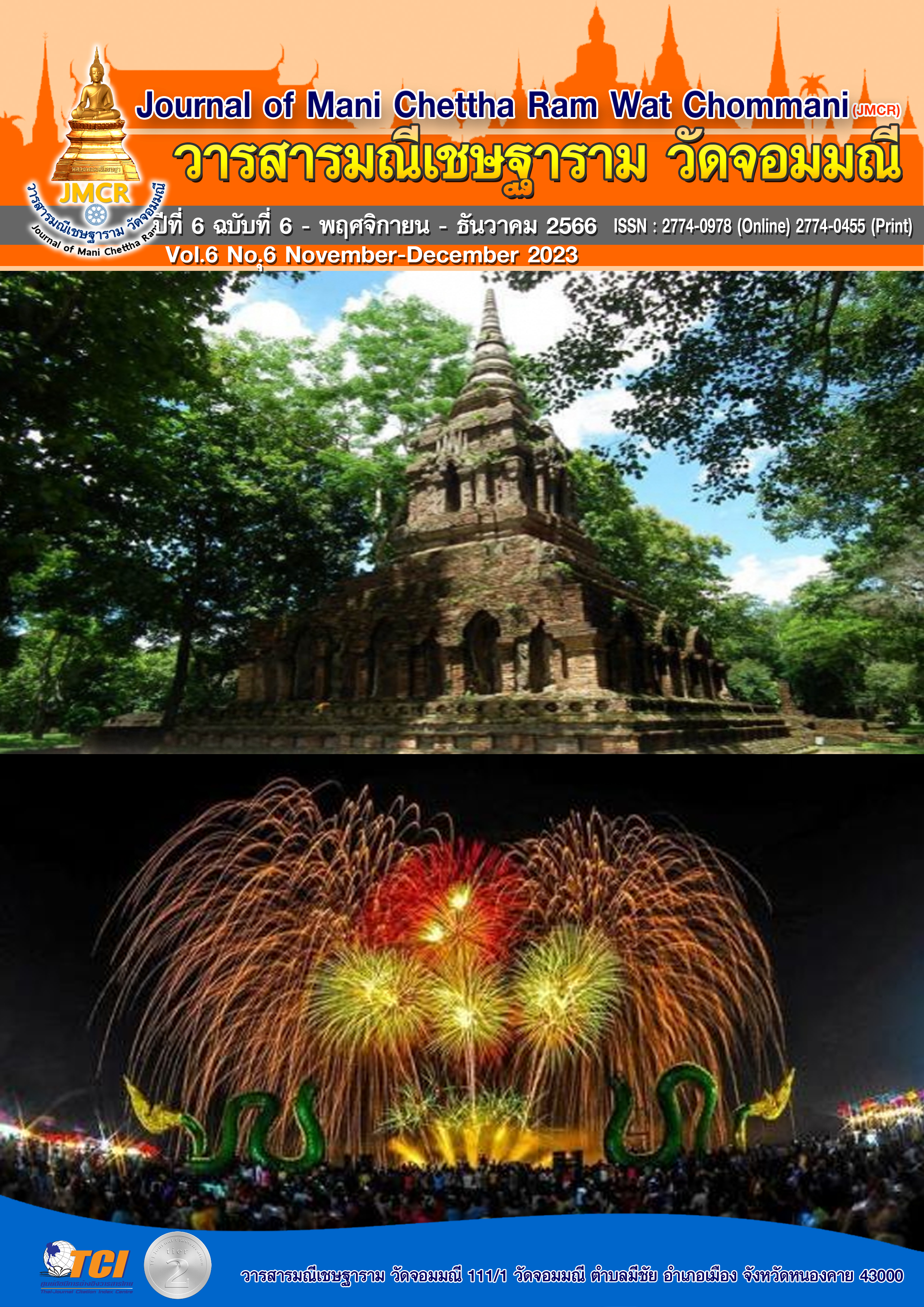RISK MANAGEMENT STRATEGIES OF GOVERNMENT ORGANZATIONS IN THE COVID-19 ERA
Keywords:
Strategy, Risk Management, Government Organization, COVID-19 EraAbstract
The spread of the COVID-19 virus affects government administration that is unable to perform its mission effectively, thus affecting the resolution of people's suffering. This research aims to 1) study the problems and obstacles related to risk management government organizations in the COVID-19 era, and 2) study risk management strategies for government organizations in the era of COVID-19. The research model was qualitative. Collected data from key informants, namely: senior, middle and primary executives of government organizations. 20 operational level officers by purposive selection. The research tool was an interview. An in-depth interview was used. The data were analyzed using a descriptive summary method.
The results found that 1) the problems and obstacles related to risk management of government organizations in the era of COVID-19 found that the new working style reduced the efficiency of risk management of the organization. Personnel lack awareness, knowledge and cooperation. The organization's risk management plan was redundant, unclear, and the management did not see the importance of risk management, and 2) The risk management strategies for government organizations in the COVID-19 era were closely followed up to prepare to respond in accordance with the situation crisis management. Take lessons learned and review risk management guidelines to determine policies, guidelines and new risk management models in line with the situation flexibility in management, adapt a new working style, determine measures to take care of the safety and health of personnel stakeholders and service recipients human resource management, give importance to the use of technology in human resource management to the development of effective human resources and working style in the situation of the COVID-19 epidemic, both internal and external environments were assessed, prepare a strategic response plan, emergency plan, and communicate to create understanding.
References
กระทรวงการคลัง. (2564). แนวทางการบริหารจัดการความเสี่ยงสําหรับหน่วยงานของรัฐเรื่องหลักการบริหารจัดการความเสี่ยงระดับองค์กร. กรุงเทพมหานคร: กระทรวงการคลัง.
ขัตติยา ด้วงสำราญ. (2563). บริหารความเสี่ยงอย่างไรให้องค์กรไร้วิกฤต. วารสารสหวิทยาการ มนุษยศาสตร์และสังคมศาสตร์, 4(1), 340-351.
จรรยรัศม์ อินนพคุณ และเฉลิมพร เย็นเยือก. (2563). การจัดการความเสี่ยงในหน่วยงานภาครัฐ กรณีศึกษาหน่วยงานราชการอำเภอเมือง จังหวัดสระบุรี. วารสารรัชต์ภาคย์ (สาขามนุษยศาสตร์และสังคมศาสตร์), 14(33), 91-104.
ชิน ฮอนมา. (2563). ประเมินความพร้อมขององค์กร 6 ด้านในการรับมือวิกฤตการแพร่ระบาดของโควิด- 19. เรียกใช้เมื่อ 22 สิงหาคม 2564 จาก https://www.pwc.com/th/en/pwc-thailand- blogs/blog- 20200424.html
ฉัตรปวีณ์ จรัสวราวัฒน์. (2556). การบริหารงานในองค์กรในช่วงเหตุการณ์ที่วิกฤต. วารสารบัณฑิตศึกษามนุษยศาสตร์และสังคมศาสตร์, 2(1), 1-14.
นงนุช อุณอนันต์ และธัชพงศ์ เศรษฐบุตร. (2563). กลยุทธ์การบริหารองค์กรฝุาวิกฤตโควิด-19. The 4th International Multi-Conference of Management Science 2020, 402–409.
ปกรณ์ อุดมธนะสารสกุล. (2564). อิทธิพลของนโยบายรัฐบาลและการจัดการภาวะวิกฤติที่มีต่อกลยุทธ์การดำเนินงานของวิสาหกิจขนาดกลางและขนาดย่อมภาคบริการในจังหวัดเชียงใหม่ในช่วงวิกฤติของโรคระบาดโควิด-19. วารสารการบัญชีและการจัดการ มหาวิทยาลัยมหาสารคาม, 13(2), 75-92.
ประชาชาติธุรกิจ. (2564). โควิด-19 เปลี่ยนโลก “ธุรกิจ” ปรับรอบทิศรับโจทย์ใหม่. เรียกใช้เมื่อ 13 สิงหาคม 2564, จาก https://www.prachachat.net/economy/news-584527
ระเบียบ สวนพันธุ์ . (2560). การรับรู้การบริหารความเสี่ยงของบุคลากรคณะวิทยาศาสตร์และเทคโนโลยี มหาวิทยาลัยธรรมศาสตร์. ม.ป.ท.: มหาวิทยาลัยธรรมศาสตร์.
วิโรจน์ ก่อสกุล. (2563). เอกสารประกอบการบรรยายกระบวนวิชาระเบียบวิธีวิจัยทางรัฐประศาสนศาสตร์. กรุงเทพมหานคร: มหาวิทยาลัยรามคำแหง.
ศูนย์วิเคราะห์เศรษฐกิจ ทีเอ็มบี. (2564). เจาะแนวโน้มธุรกิจไทยปี 2564 ท่ามกลางคลื่นมรสุมโควิด. เรียกใช้เมื่อ 12 สิงหาคม 2564 จาก https://www.ttbbank.com/archive/en/analytics/indus try-analysis/view/ThaiBus-COV-2021.html
สุภางค์ จันทวานิช. (2561). วิธีการวิจัยเชิงคุณภาพ. (พิมพ์ครั้งที่ 24). กรุงเทพมหานคร: สำนักพิมพ์แห่งจุฬาลงกรณ์มหาวิทยาลัย.
สำนักข่าว Hfocus. (2564). ถอดบทเรียนแนวปฏิบัติหน่วยงานรัฐในภาวะโควิดจุดเริ่มการก้าวสู่e-Service. เรียกใช้เมื่อ 17 สิงหาคม 2564, จาก https://www.hfocus.org/content/2022/04/24976
สำนักงานสรรพสามิตพื้นที่หนองคาย สาขาเมืองหนองคาย. (2563). คู่มือการบริหารความเสี่ยงต่อสถานการณ์การแพร่ระบาดโรคติดเชื้อไวรัสโคโรนา 2019 (COVID-19). หนองคาย: สำนักงานสรรพสามิตพื้นที่หนองคาย.
สำนักงานพัฒนารัฐบาลดิจิทัล. (2562). การบริหารความเสี่ยงอย่างมืออาชีพในยุค Digital Disruption. เรียกใช้เมื่อ 12 สิงหาคม 2564, จาก https://www.dga.or.th/document-sharing/article/36379/
สถาบันป้องกันควบคุมโรคเขตเมือง. (2563). แนวทางการบริหารความเสี่ยงองค์กร. กรุงเทพมหานคร: สถาบันป้องกันควบคุมโรคเขตเมือง.
องค์กรบริหารส่วนตําบลทุ่งกอ จังหวัดเชียงราย. (ม.ป.ป.). คู่มือบริหารความเสี่ยง. สืบค้นเมื่อ 30 พฤษภาคม 2564, จาก http://www.tkr.go.th
อภิสิทธิ์ เหมาะสมสกลุ. (2547). การสื่อสารภาวะวิกฤต: กรณีศึกษาเปรียบเทียบโรคซาร์ส และโรค ไข้หวัดนกของกระทรวงสาธารณสุข. รายงานเฉพาะบุคคล บัณฑิตวิทยาลัยมหาวิทยาลัยธรรมศาสตร์.
Gray, F. C., & Larson, W. E., (2006). Project Management: The Management Process. Singapore: McGraw-Hill.
Koch, M. W., & Fairly, T. M. (1993). Integrated Quality Management: The key to Improving Nursing Care Quality. Louise: Mosby Year Book.
Miller, K. S., & Iscoe, I. (1963). The Concept of Crisis: Current Status and Mental Health Implications. Human Organization, 22, 195–201.
Roth, J. (2007). Categorizing Risk: Risk Categories Help Users Identify, Understand, And Monitor Their Organizations’ Potential Risks-risk Watch. Retrieved 22 August, 2021, from http://findartictes.com/p/articles/mi_m4153/ is_2_59/ai_85014799.
The Committee of Sponsoring Organizations of the Tread way Commission (COSO). (2017). Enterprise Risk Management Integrating with Strategy and Performance Executive Summary. Retrieved September 11, 2021, from https://www.coso.org/Documents/2017-COSO-ERM-IntegratingwithStrategy-and-Performance-ExecutiveSummary.pdf.
Wilson , J., & Tiger, J. (1999). Clinical Risk Modification: A Route to Clinical Governance. Oxford: Butterworth-Heinemann.



